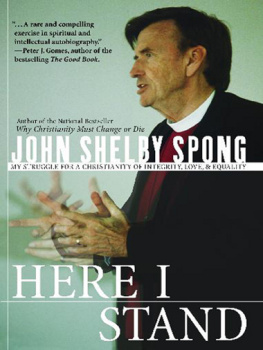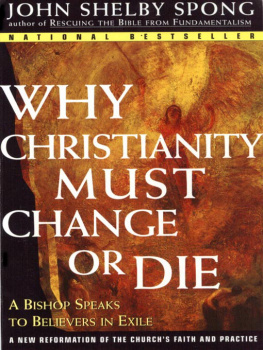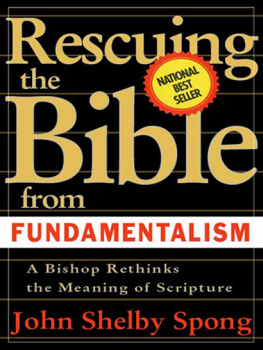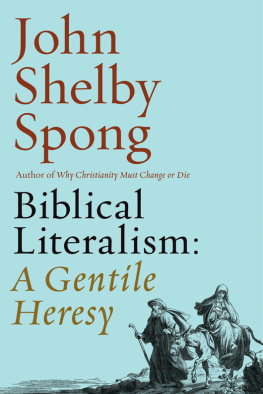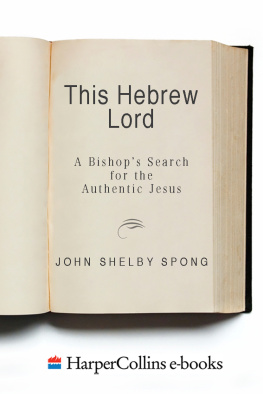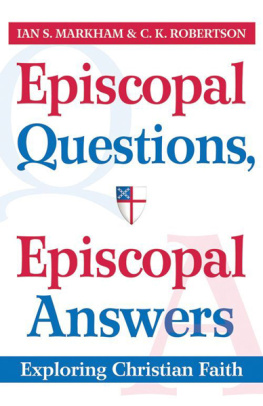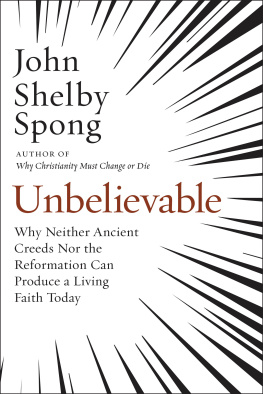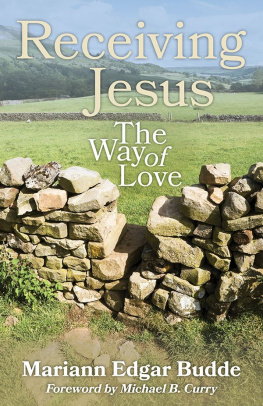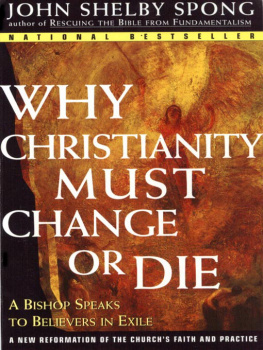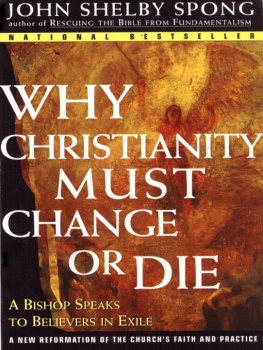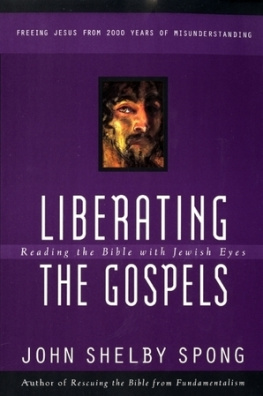Spong - Here I Stand
Here you can read online Spong - Here I Stand full text of the book (entire story) in english for free. Download pdf and epub, get meaning, cover and reviews about this ebook. year: 2009, publisher: HarperCollins, genre: Religion. Description of the work, (preface) as well as reviews are available. Best literature library LitArk.com created for fans of good reading and offers a wide selection of genres:
Romance novel
Science fiction
Adventure
Detective
Science
History
Home and family
Prose
Art
Politics
Computer
Non-fiction
Religion
Business
Children
Humor
Choose a favorite category and find really read worthwhile books. Enjoy immersion in the world of imagination, feel the emotions of the characters or learn something new for yourself, make an fascinating discovery.
- Book:Here I Stand
- Author:
- Publisher:HarperCollins
- Genre:
- Year:2009
- Rating:5 / 5
- Favourites:Add to favourites
- Your mark:
- 100
- 1
- 2
- 3
- 4
- 5
Here I Stand: summary, description and annotation
We offer to read an annotation, description, summary or preface (depends on what the author of the book "Here I Stand" wrote himself). If you haven't found the necessary information about the book — write in the comments, we will try to find it.
Here I Stand — read online for free the complete book (whole text) full work
Below is the text of the book, divided by pages. System saving the place of the last page read, allows you to conveniently read the book "Here I Stand" online for free, without having to search again every time where you left off. Put a bookmark, and you can go to the page where you finished reading at any time.
Font size:
Interval:
Bookmark:
Here I Stand
My Struggle for a Christianity of Integrity, Love, and Equality

JOHN SHELBY SPONG

This book is dedicated to those who shaped my life personally:
My parents, John Shelby Spong (18891943) and
Doolie Boyce Griffith Spong (19071999)
My first wife, Joan Lydia Ketner Spong (19291988)
Our children, Ellen Elizabeth, Mary Katharine, and
Jaquelin Ketner Spong
My second wife, Christine Mary Spong
My stepchildren, Brian Yancy and Rachel Elizabeth Barney
Our grandchildren, Shelby and Jay Catlett, and John and Lydia Hylton
And to those who shaped my life professionally:
William Wall Whiddit, choirmaster
Robert Littlefield Crandall, rector
Janet Robinson, teacher
William H. Poteat, teacher
Edwin Anderson Penick, bishop
William Belser Spong, Jr., cousin, senator
David Watt Yates, college rector
Richard Henry Baker, bishop
Marian Alston Bourne, mentor
John A. T. Robinson, mentor
William Henry Marmion, bishop
John Elbridge Hines, bishop and ultimate role model
Desmond Tutu, bishop and Nobel Prize winner
Jack Daniel Spiro, rabbi
Don Cupitt, mentor
Michael Donald Goulder, mentor
Jack Marston McKelvey, bishop
John Palmer Croneberger, bishop
Trusted advisers:
Ward J. Herbert | Marjorie L. Christie |
Eliot S. Knight | Harry E. Smith |
Michael F. Rehill | Gerrie H. Jeter |
William L. Heick | John E. Lynch |
E. Louie Crew | John G. Zinn |
Phillip C. Cato | Michael P. Francaviglia |
Dale Gruner | Marilyn Conrad |
I N MANY WAYS , writing an autobiography has a touch of arrogance about it. The author has to assume that his or her life will be of interest to a reading public. This is true, I suspect, only if that life has been involved in issues that have helped determine and shape the lives of others. Otherwise, reading it is like watching someones home movies. When my editors at HarperCollins first broached the idea of this book, I was both flattered and filled with hesitancy, perhaps even fear. It was, however, a task that also appealed to me, not for reasons of serving an ever present ego, but rather because it afforded me an opportunity to review my life, to reassess major decisions, to make new judgments, and to revisit both the valleys through which I have walked and the mountaintops where I have been enabled to see visions not always discernible to others.
An autobiography is by definition subjective. This book is my view of the experiences through which I have lived. I have worked hard to make certain I have both my facts and my dates correct, though I suspect in time someone will demonstrate that in one or two places I was mistaken. My major emphasis, however, was to share my personal interpretations of the experiences associated with those facts and dates. Inevitably, I have been forced to make judgments about people and events. That is the nature of an autobiography. I hope I have not been unfair in doing so, but I suspect that those not flattered by my descriptions of them will think I have been. My goal has been to hold up a mirror to friend and foe alike and, when the reflection was visible, to say this is how you looked to me. That is not to claim objective truth for my perception, nor is it to assert that my version is, in fact, who anyone is. Rather, it is to say that, given who I am and the values I represent, this is how I have experienced you. I have tried in these descriptions to be scrupulously honest, yet avoid as much as possible any small-minded pettiness.
I have loved revisiting the various episodes of my life and the terrain over which I have been privileged to walk. In some sense this has helped me to bring about some closures that might never otherwise have been available to me. I had to recreate and thus to relive, for example, my childhood feelings for such primary people as my father, who died when I was twelve and who left me with lots of unhealed wounds from our incomplete relationship. But I also could chronicle the healing that occurred when I found a surrogate father in the person of my rector, Robert Crandall, who helped me discover my own call to the priesthood. I visited anew the experience I had with my first shaping undergraduate professor, named William H. Poteat, at the University of North Carolina, who taught me how to think as he taught me philosophy, and later with gigantic heroes like John E. Hines and John A. T. Robinson, both bishops, who modeled for me in very different ways what an episcopal career based on a vision of the future could look like.
I also had great fun reliving my days in the various congregations I served: St. Josephs, Durham, North Carolina; Calvary Parish, Tarboro, North Carolina; St. Johns, Lynchburg, Virginia; and St. Pauls in Richmond. To add to these opportunities a professional life of almost a quarter of a century as a bishop in that part of northern New Jersey known as the Diocese of Newark, a very special, open, and honest community of faith, was more than any person might have expected in a lifetime. I have been touched by some incredible people, both men and women, over these years who have helped to create the person I now am. Many, but obviously not all, of their names will appear in these pages.
The actual physical work on this book consumed three years of my writing career. From the time I signed the contract to do it, in 1994, it has been present, even if just in the back of my mind. I first began to put my thoughts on paper while in New Zealand in 1997. Fortunately for the completion of this task, I have over the years thrown away almost nothing! I have kept massive files, scrapbooks, date books, and calendars for every year of my professional career, which began with my ordination in 1955 and continued until my retirement forty-five years later in 2000. Clearing out those files when this book was complete was not the easiest emotional task I have ever faced.
The thing that frightened me most in preparing this volume was how would I tell the story of my wife, Joan, who died of cancer in 1988. Not only did I love her very much, but I did not want in any way to diminish either her memory or her gifts to the world, to me, or to our daughters. But her mental illness, which she endured overtly for fifteen years, was such a major piece of our familys history and provided so powerful a background to both my personal and my professional life that I could not omit it. I hope, for her sake and for the sake of our daughters, in whom she still lives so obviously and so beautifully, I have done this with sensitivity, kindness, and the love I still have for her. I wanted this recounting to be both realistic and a contribution to the joy of her memory.
I am particularly indebted to the clergy and people of our diocese, who called me to be their bishop in 1976 and who have lived with me in that wonderful, mature, and creative tension in which we sought together to affirm diversity, to respect differences, and to create an environment in which each person can be called and empowered to be the deepest, fullest self possible, for that is what I believe the church, known as the Body of Christ, is designed to do.
Many people helped me in researching this book. Harold (Packy) Morris, a boxing fan in our church in Jersey City, helped me get the details of the Louis-Braddock, Louis-Schmeling, and Louis-Conn heavyweight championship fights that enabled me to frame the issues of racism in my early life. The Reverend Lawrence Falkowski, our priest in West Orange, went on the Internet to get me details of historical events in the public arena around which my own life revolved. Marilyn (Lyn) Conrad, my executive secretary, got the dates from the library reference department when obscure people served in Congress and in the Senate so that my story would have an accurate factual basis. My wife, Christine, ran down details in a variety of places that fleshed out my narrative. Each of my daughters challenged my memory of certain events in which they had shared and forced me to investigate further until I usually discovered that they were right and I was wrong. I would have sworn, for example, that I was in Charlottesville, Virginia, watching a basketball game the night before I was elected bishop, but they demonstrated conclusively that I was in Landover, Maryland, and my daughters Ellen and Katharine were with me. So I corrected that. I could not correct, however, the fact that the University of Virginia, their alma mater, defeated the University of North Carolina, my alma mater, on that particular night.
Font size:
Interval:
Bookmark:
Similar books «Here I Stand»
Look at similar books to Here I Stand. We have selected literature similar in name and meaning in the hope of providing readers with more options to find new, interesting, not yet read works.
Discussion, reviews of the book Here I Stand and just readers' own opinions. Leave your comments, write what you think about the work, its meaning or the main characters. Specify what exactly you liked and what you didn't like, and why you think so.

